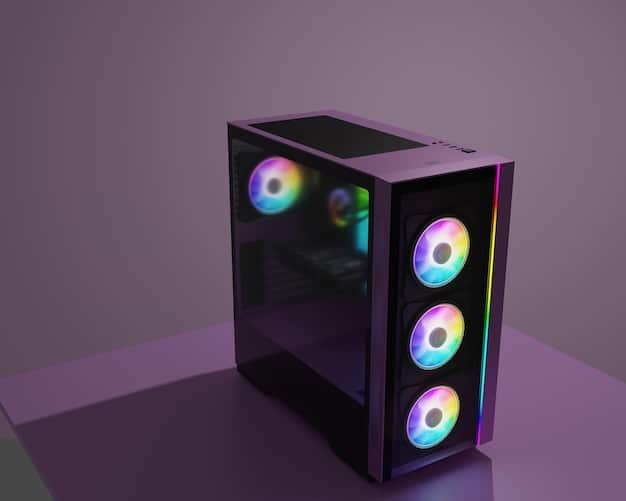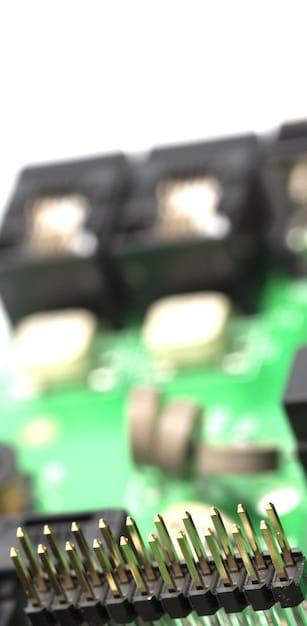Build a Gaming PC Under $1500 in 2025: The Ultimate US Guide

The Ultimate Guide to Building a Custom Gaming PC in the US for Under $1500 in 2025 walks you through selecting components, assembly, software setup, and troubleshooting, ensuring a high-performance gaming experience within your budget.
Ready to build your dream gaming PC without breaking the bank? This The Ultimate Guide to Building a Custom Gaming PC in the US for Under $1500 in 2025 will walk you through every step, from choosing the right components to assembling your machine and optimizing its performance.
Choosing the Right Components
Selecting the right components is crucial when building a gaming PC. You need to strike a balance between performance and budget to ensure you get the most bang for your buck. Let’s break down the critical components and how to choose them wisely.
CPU (Central Processing Unit)
The CPU is the brain of your PC, responsible for executing instructions and performing calculations. For gaming, a mid-range CPU with a good balance of cores and clock speed is ideal.
GPU (Graphics Processing Unit)
The GPU is arguably the most important component for gaming. It handles the rendering of graphics and the overall visual experience. Aim for a mid-range GPU that can handle modern games at 1080p or 1440p resolutions.
- AMD Ryzen 5 5600X: Offers excellent performance for its price, making it a great choice for budget builds.
- NVIDIA GeForce RTX 3060: A solid mid-range GPU that can handle most games at 1080p and even 1440p with reasonable settings.
- Intel Core i5-12400F: Provides a great balance of performance and price, suitable for gaming and other tasks.
By carefully selecting these crucial components, you can lay the foundation for a powerful and cost-effective gaming PC.

Motherboard and Memory Selection
The motherboard acts as the backbone of your PC, connecting all the components together. Memory (RAM) is crucial for handling multiple tasks and ensuring smooth gameplay. Here’s how to choose the right ones for your build.
Choosing a Compatible Motherboard
The motherboard must be compatible with your CPU socket type (e.g., AM4 for Ryzen, LGA 1700 for Intel) and form factor (ATX, Micro-ATX, Mini-ITX). It should also have enough slots for RAM, GPUs, and storage devices.
RAM (Random Access Memory)
Aim for at least 16GB of DDR4 RAM with a speed of 3200MHz or higher. This will provide ample memory for modern games and multitasking. Consider the number of RAM slots on your motherboard when purchasing RAM modules.
- ASRock B450M Steel Legend: A reliable and affordable motherboard for Ryzen CPUs.
- Corsair Vengeance LPX 16GB (2x8GB) DDR4 3200MHz: A popular and reliable RAM kit that offers great performance.
- MSI B550-A PRO: A well-rounded motherboard with PCIe Gen4 support and robust features.
Selecting the correct motherboard and RAM will ensure your components work seamlessly together and provide the necessary performance for your gaming rig.
Storage and Power Supply Considerations
Storage and power supply are essential for the functionality and stability of your gaming PC. Choosing the right ones can significantly impact your system’s performance and longevity. Let’s discuss how to make informed decisions about these components.
Storage: SSD vs. HDD
For your primary drive, opt for a Solid State Drive (SSD) for faster boot times and game loading. A 500GB or 1TB NVMe SSD is ideal. You can add a Hard Disk Drive (HDD) for additional storage if needed.
Power Supply Unit (PSU)
The PSU provides power to all your components. Choose a PSU with enough wattage to handle your system’s power requirements with some headroom for future upgrades. A 650W 80+ Bronze certified PSU is a good starting point.
- Samsung 970 EVO Plus 1TB NVMe SSD: Offers blazing-fast read and write speeds, improving overall system responsiveness.
- Seasonic FOCUS GX-650 650W 80+ Gold PSU: A reliable and efficient power supply with ample wattage for most mid-range gaming builds.
- Western Digital Blue 2TB HDD: A cost-effective storage solution for storing large game files and media.
Proper storage and a reliable PSU are crucial for a smooth gaming experience and ensuring the long-term stability of your PC.

Case Selection and Cooling Solutions
The PC case not only houses your components but also plays a vital role in cooling and airflow. Proper cooling is essential to prevent overheating and maintain optimal performance. Let’s dive into choosing the right case and cooling solutions.
Choosing a PC Case
Select a case that fits your motherboard form factor and has good airflow. Look for cases with multiple fan mounting points and cable management options. Consider aesthetics and personal preference when making your choice.
CPU Cooler
A good CPU cooler is essential to keep your CPU running at optimal temperatures. Air coolers are generally more affordable, while liquid coolers offer better performance but come at a higher price.
- NZXT H510: A sleek and minimalist case with good airflow and cable management options.
- Cooler Master Hyper 212 EVO: A popular and affordable air cooler that provides excellent cooling performance.
- Corsair iCUE H100i Elite Capellix: A high-performance liquid cooler with customizable RGB lighting.
By carefully selecting a case that promotes good airflow and pairing it with an effective CPU cooler, you can ensure your components stay cool and perform optimally, even during intense gaming sessions.
Assembly: Step-by-Step Guide
Assembling your gaming PC can seem daunting, but with the right guidance, it’s a manageable and rewarding experience. Follow these steps to ensure a smooth and successful build.
Preparing Your Workspace
Before you begin, clear a well-lit, spacious workspace. Gather all your components, tools (screwdriver, anti-static wrist strap), and the motherboard manual.
Installing Components
Start by installing the CPU on the motherboard, followed by the RAM modules. Then, mount the motherboard inside the case and install the GPU, SSD, and HDD. Connect the PSU and route the cables neatly.
- CPU Installation: Carefully align the CPU with the socket and gently lower it into place.
- RAM Installation: Align the notches on the RAM modules with the slots and push them in until they click.
- GPU Installation: Insert the GPU into the PCIe slot and secure it with screws.
Take your time and double-check each step to avoid any mistakes. Refer to online tutorials and the component manuals if you need additional help.
Software Installation and Optimization
Once your PC is assembled, the next step is to install the operating system and drivers. Proper software installation and optimization are crucial for a smooth and efficient gaming experience.
Installing the Operating System
Create a bootable USB drive with your preferred operating system (Windows 10/11). Boot from the USB drive and follow the on-screen instructions to install the OS on your SSD.
Installing Drivers
Install the latest drivers for your motherboard, GPU, and other components. These drivers can be found on the manufacturers’ websites. Keep your drivers updated for optimal performance.
- Windows 10/11 Installation: Follow the setup wizard and activate your copy of Windows.
- NVIDIA/AMD Driver Installation: Download and install the latest drivers from NVIDIA’s or AMD’s website.
- BIOS Updates: Check for BIOS updates on your motherboard manufacturer’s website and update if necessary.
By ensuring you have the latest software and drivers, you can maximize the performance of your gaming PC and enjoy a smooth and stable gaming experience.
Troubleshooting and Maintenance
Even with careful planning and assembly, issues can arise. Knowing how to troubleshoot common problems and maintain your PC will keep it running smoothly for years to come.
Common Issues
Common issues include no display, system crashes, overheating, and driver conflicts. Use diagnostic tools and online resources to identify and resolve these problems.
Regular Maintenance
Regularly clean your PC to remove dust and debris, which can cause overheating. Check cable connections and update drivers to prevent performance issues. Consider using monitoring software to keep track of your system’s health.
- Dust Removal: Use compressed air to clean fans, heatsinks, and other components.
- Cable Management: Ensure cables are neatly routed to improve airflow and prevent tangling.
- Software Updates: Keep your operating system, drivers, and games updated to ensure compatibility and performance.
By addressing issues promptly and performing regular maintenance, you can extend the lifespan of your gaming PC and ensure it continues to deliver optimal performance.
| Key Component | Brief Description |
|---|---|
| 💡 CPU Choice | Select a mid-range CPU like AMD Ryzen 5 5600X or Intel Core i5-12400F for balanced performance. |
| 🎮 GPU Selection | Opt for NVIDIA GeForce RTX 3060 for 1080p/1440p gaming at reasonable settings. |
| 💾 Storage Solutions | Use a 1TB NVMe SSD for fast boot and loading times; add a 2TB HDD for extra storage. |
| ❄️ Cooling Needs | Choose a Cooler Master Hyper 212 EVO or Corsair iCUE H100i for efficient cooling. |
FAQ
▼
The GPU (Graphics Processing Unit) is arguably the most crucial component, as it handles the rendering of graphics, directly impacting the visual experience and gaming performance.
▼
Aim for at least 16GB of DDR4 RAM with a speed of 3200MHz or higher. This provides ample memory for modern games and multitasking, ensuring smoother gameplay.
▼
Opt for a Solid State Drive (SSD) for your primary drive. SSDs offer significantly faster boot times and game loading speeds compared to traditional Hard Disk Drives (HDDs).
▼
Select a case with good airflow, use an effective CPU cooler (air or liquid), and regularly clean your PC to remove dust, ensuring optimal temperatures during gaming sessions.
▼
Choose a PSU with enough wattage to handle your system’s power requirements. A 650W 80+ Bronze certified PSU is a good starting point, providing headroom for future upgrades.
Conclusion
Building a custom gaming PC for under $1500 in the US for 2025 is entirely achievable with careful planning and component selection. By following this guide, you’ll be well-equipped to assemble a powerful and cost-effective gaming rig that delivers an exceptional gaming experience.


![Quantum Computing for Beginners: A US Geek's Guide [2025] Quantum Computing for Beginners: A US Geek's Guide [2025] - Cover Image](https://dorama2you.com/wp-content/uploads/2025/06/dorama2you.com_3_1749769492_79bdbcc1_cover-360x180.jpg)


